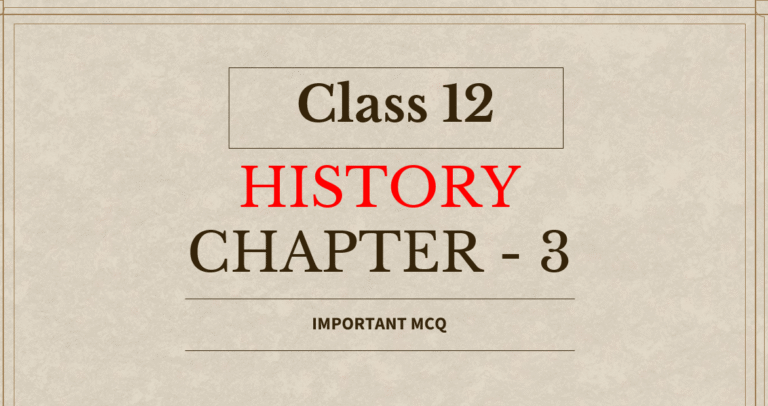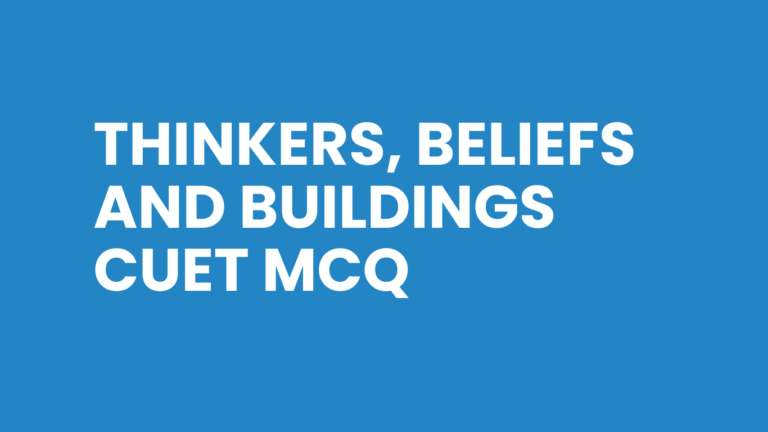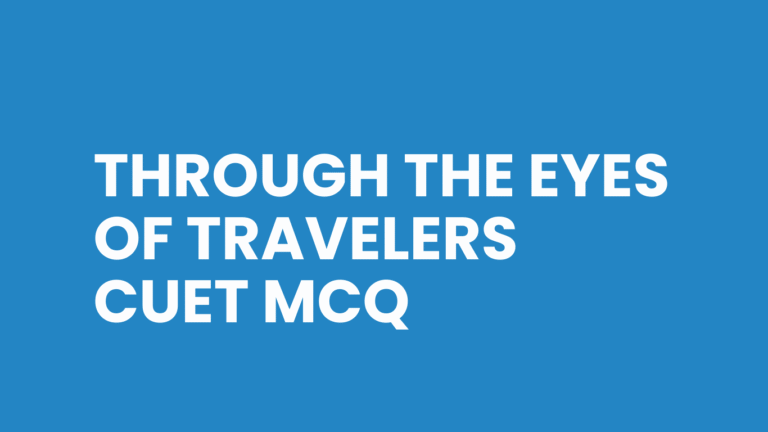Kings, Farmers, and Towns CUET MCQ | Class 12 History Chapter 2 Most Important MCQ for CUET 2026
This article will provide you with Class 12 History Chapter 2 CUET important MCQs. Kings, Farmers, and Towns CUET MCQ can help you strengthen your CUET preparation and score good grades in your exams. These Class 12 History Chapter 2 Most Important MCQ for CUET 2026 are very useful if you’re really serious about your exams.

Kings, Farmers, and Towns CUET MCQ
Kings, Farmers, and Towns CUET MCQ:
- The earliest inscriptions in India were written in which script?
a) Devanagari
b) Brahmi and Kharosthi
c) Gupta script
d) Grantha - Who deciphered the Brahmi script in 1837?
a) Alexander Cunningham
b) James Prinsep
c) Max Muller
d) R.D. Banerjee - The earliest written records of the Mauryan period are known as:
a) Vedas
b) Puranas
c) Ashokan Edicts
d) Sangam texts - Which language was mainly used in Ashokan inscriptions?
a) Sanskrit
b) Pali/Prakrit
c) Tamil
d) Persian - The Prayaga Prashasti (Allahabad pillar inscription) was composed by:
a) Harisena
b) Banabhatta
c) Kalidasa
d) Kautilya - Harisena’s Prayaga Prashasti glorifies the achievements of:
a) Ashoka
b) Samudragupta
c) Chandragupta Maurya
d) Harshavardhana - The Arthashastra, a treatise on polity and economy, is attributed to:
a) Patanjali
b) Kautilya/Chanakya
c) Panini
d) Kalhana - The Mauryan capital Pataliputra was located on the banks of which river?
a) Ganga
b) Yamuna
c) Saraswati
d) Godavari - The six major Ashokan pillar edicts are found mainly in:
a) Delhi and Allahabad
b) Sarnath, Lauria, Rampurva, Meerut, Topra, Allahabad
c) Taxila and Ujjain
d) Bodh Gaya and Rajgir - The Janapadas were followed by larger political entities known as:
a) Puranas
b) Mahajanapadas
c) Republics
d) Ganas - The term “bhaga” in the Mauryan revenue system refers to:
a) Land revenue share
b) Forced labour
c) Royal gifts
d) War tax - The earliest coins found in India are called:
a) Gold dinars
b) Punch-marked coins
c) Silver rupakas
d) Copper nishkas - Who was the Greek ambassador sent to the court of Chandragupta Maurya?
a) Antigonus
b) Seleucus Nicator
c) Megasthenes
d) Alexander - Megasthenes’ account of India is known as:
a) Indica
b) Arthashastra
c) Purana
d) Mahavamsa - Which text is considered a major source of the Mauryan economy and administration?
a) Ramayana
b) Arthashastra
c) Manu Smriti
d) Mahabharata - The Ashokan edicts were inscribed mainly on:
a) Palm leaves
b) Copper plates
c) Rocks and pillars
d) Clay tablets - Who among the following rulers is referred to as Devanampiya Piyadassi?
a) Chandragupta Maurya
b) Ashoka
c) Bindusara
d) Samudragupta - The first evidence of land grants to Brahmanas is found in:
a) Vedic texts
b) Satavahana inscriptions
c) Arthashastra
d) Gupta inscriptions - Which type of polity was prevalent in some Mahajanapadas like Vajji?
a) Monarchy
b) Republic/Gana-Sangha
c) Dictatorship
d) Confederacy - The Sanchi stupa inscription mainly belongs to which dynasty?
a) Maurya
b) Shunga
c) Gupta
d) Kushana - The first evidence of coins made of copper in India comes from:
a) Mauryan period
b) Gupta period
c) Harappan period
d) Satavahana period - The Shaka-Kshatrapa rulers issued inscriptions in which language?
a) Prakrit
b) Sanskrit
c) Greek
d) Persian - Which of the following dynasties issued the first gold coins in India?
a) Mauryas
b) Kushanas
c) Guptas
d) Satavahanas - The Junagarh rock inscription of Rudradaman is important because:
a) It is in pure Sanskrit
b) It glorifies Chandragupta Maurya
c) It was written by Megasthenes
d) It records a war with Ashoka - The Hathigumpha inscription is associated with which ruler?
a) Kharavela of Kalinga
b) Ashoka
c) Samudragupta
d) Bindusara - The guilds of merchants and craftsmen in ancient India were called:
a) Parishads
b) Shrenis
c) Mahajanas
d) Varnas - Which term refers to tax-free land grants given to Brahmanas?
a) Agrahara
b) Devadana
c) Shrenidana
d) Bhoga - The Guptas issued coins mainly made of:
a) Bronze
b) Copper
c) Gold
d) Lead - The famous iron pillar inscription (Delhi) is associated with which ruler?
a) Ashoka
b) Samudragupta
c) Chandragupta II (Vikramaditya)
d) Harshavardhana - Which of the following statements about Ashokan inscriptions is correct?
a) They were written only in Sanskrit
b) They are found only in South India
c) They were inscribed in multiple languages and scripts
d) They mention only conquests and wars
Kings, Farmers, and Towns CUET MCQ Answer Key
Answer Key:
1-b, 2-b, 3-c, 4-b, 5-a, 6-b, 7-b, 8-a, 9-b, 10-b, 11-a, 12-b, 13-c, 14-a, 15-b, 16-c, 17-b, 18-b, 19-b, 20-b, 21-a, 22-a, 23-b, 24-a, 25-a, 26-b, 27-a, 28-c, 29-c, 30-c





